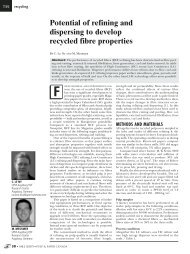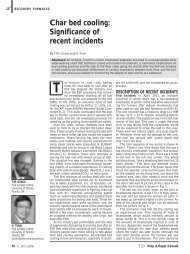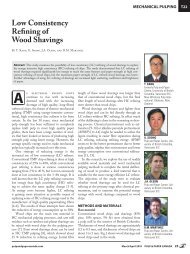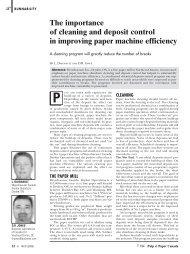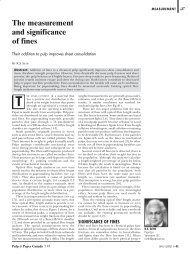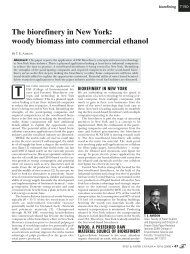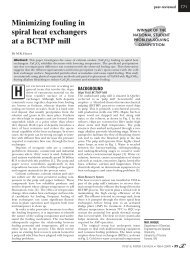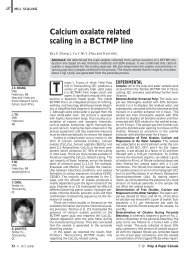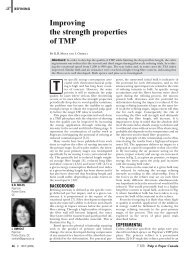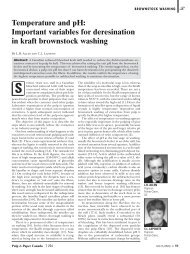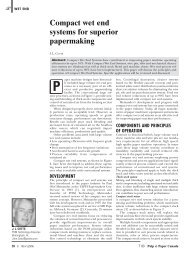Fines from deinked pulp: Effect of contaminants on their ...
Fines from deinked pulp: Effect of contaminants on their ...
Fines from deinked pulp: Effect of contaminants on their ...
Create successful ePaper yourself
Turn your PDF publications into a flip-book with our unique Google optimized e-Paper software.
BRIGHTNESSTABLE III. ISO brightness (%) <str<strong>on</strong>g>of</str<strong>on</strong>g> the short fracti<strong>on</strong>s (fines)obtained after different bleaching sequences (brightnesschanges are in parentheses).BleachingSequence DIP TMP UNP:UMGFIG. 3. ISO brightness <str<strong>on</strong>g>of</str<strong>on</strong>g> DIP and TMP furnishes, c<strong>on</strong>sisting<str<strong>on</strong>g>of</str<strong>on</strong>g> the bleached (QPY) l<strong>on</strong>g fracti<strong>on</strong> mixed with <strong>their</strong>respective bleached (QPY) fines counterparts, in ratiosranging <str<strong>on</strong>g>from</str<strong>on</strong>g> 70:30 to 100:0 l<strong>on</strong>g fracti<strong>on</strong>: fines.Untreated 47.7 52.6 56.9Y 49.4 56.5 —(+1.7) (+3.9)QY or 54.4 59.5 —AY (+6.7) (+6.9)P 45.4 62.6 57.5(–2.3) (+10.0) (+0.6)QP or *50.0* 66.5 67.2AP (+2.3) (+13.9) (+10.3)QPY or *55.7* 70.4 68.8APY (+8.0) (+17.8) (+11.9)*: A 1.2% EDTA charge was applied in the Q-stage and 0.2% MgSO 4added in the P-stage, a departure <str<strong>on</strong>g>from</str<strong>on</strong>g> the procedure described in theexperimental secti<strong>on</strong>.ti<strong>on</strong>ated <str<strong>on</strong>g>pulp</str<strong>on</strong>g>s differed: DIP had thelowest ISO brightness at 66.9%, followedby UNP:UMG at 72.1% and TMP at74.1%. The same order was seen forthe ISO brightnesses <str<strong>on</strong>g>of</str<strong>on</strong>g> the bleachedfines: DIP, 55.7%; UNP:UMG, 68.8%; andTMP 70.4%.The above results indicate that the lowfinal brightness <str<strong>on</strong>g>of</str<strong>on</strong>g> the DIP after QPY wasa direct c<strong>on</strong>sequence <str<strong>on</strong>g>of</str<strong>on</strong>g> the poor bleachabilityand low brightness <str<strong>on</strong>g>of</str<strong>on</strong>g> the DIP fines.To c<strong>on</strong>firm this, we measured the ISObrightness <str<strong>on</strong>g>of</str<strong>on</strong>g> DIP and TMP furnishes,c<strong>on</strong>sisting <str<strong>on</strong>g>of</str<strong>on</strong>g> the bleached (QPY) l<strong>on</strong>gfracti<strong>on</strong>s mixed with <strong>their</strong> respectivebleached (QPY) fines, in ratios ranging<str<strong>on</strong>g>from</str<strong>on</strong>g> 70:30 to 100:0 l<strong>on</strong>g fracti<strong>on</strong>:fines.The results, Fig. 3, show that the 100:0DIP furnish had an ISO brightness <str<strong>on</strong>g>of</str<strong>on</strong>g>75.1%, while the 70:30 DIP furnish had abrightness <str<strong>on</strong>g>of</str<strong>on</strong>g> 66.4%, a drop <str<strong>on</strong>g>of</str<strong>on</strong>g> 8.7 brightnesspoints. Under the same c<strong>on</strong>diti<strong>on</strong>swith TMP, the ISO brightness went <str<strong>on</strong>g>from</str<strong>on</strong>g>76.7% to 74.7%, a drop <str<strong>on</strong>g>of</str<strong>on</strong>g> <strong>on</strong>ly 2.0 brightnesspoints.<str<strong>on</strong>g>Fines</str<strong>on</strong>g> Bleachability: The bleachability <str<strong>on</strong>g>of</str<strong>on</strong>g>the fines <str<strong>on</strong>g>of</str<strong>on</strong>g> the three furnishes, obtained<str<strong>on</strong>g>from</str<strong>on</strong>g> the float wash fracti<strong>on</strong>ator, wasevaluated for the following bleachingsequences: Y, QY, AY, P, QP, AP, QPYand APY. Again, A and Q treatmentswere equivalent and thus tabulated together.Table III summarizes thesebleaching results.— <str<strong>on</strong>g>Fines</str<strong>on</strong>g> bleaching: DIP vs. TMP: DIP finesdid not resp<strong>on</strong>d as well as TMP fines toperoxide or hydrosulphite bleaching. Thehigh 450-ppm ERIC value <str<strong>on</strong>g>of</str<strong>on</strong>g> the DIPfines, compared to <strong>on</strong>ly 75 ppm for theTMP fines, explains the low brightnessceiling and partially explains the poorapparent bleachability <str<strong>on</strong>g>of</str<strong>on</strong>g> the DIP fines.The higher level <str<strong>on</strong>g>of</str<strong>on</strong>g> ir<strong>on</strong> in the DIP finesaccounts for the remaining difference inbleaching resp<strong>on</strong>se.Using the following equati<strong>on</strong>s,Brightness= 1 + k/s – (2 k/s + (k/s) 2 ) 1/2k (fines+ink) = k fines + c ink k inks (fines+ink) = s fineswhere k is the absorpti<strong>on</strong> coefficient, s thescattering coefficient, c ink the ink c<strong>on</strong>centrati<strong>on</strong>and k ink = 15000 m 2 /kg [5], <strong>on</strong>e cancalculate the effect <str<strong>on</strong>g>of</str<strong>on</strong>g> ink <strong>on</strong> brightness.The DIP fines had an ISO brightness <str<strong>on</strong>g>of</str<strong>on</strong>g>47.7%, a scattering coefficient, s (fines+ink) ,<str<strong>on</strong>g>of</str<strong>on</strong>g> 100 m 2 /kg and an ERIC value <str<strong>on</strong>g>of</str<strong>on</strong>g> 450ppm. We calculated that k (fines+ink) = 28.7m 2 /kg, k fines = 21.9 m 2 /kg and (c ink k ink ) =6.8 m 2 /kg. If ink was absent, thenk (fines+ink) = k fines = 21.9 m 2 /kg, and theinkless brightness would be 52.2%.During the QPY sequence, k ink <str<strong>on</strong>g>of</str<strong>on</strong>g> blackink remains unchanged and therefore, forthe ink-c<strong>on</strong>taining DIP fines to gain 8.0brightness points over-all and reach55.7%, the brightness <str<strong>on</strong>g>of</str<strong>on</strong>g> the DIP finesal<strong>on</strong>e would have to be 63.0% i.e.,(k (fines+ink) would need to be 17.6 m 2 /kgand k fines 10.9 m 2 /kg). For the ink-c<strong>on</strong>tainingDIP fines to have a brightness <str<strong>on</strong>g>of</str<strong>on</strong>g>68%, the fines al<strong>on</strong>e would have to reacha brightness <str<strong>on</strong>g>of</str<strong>on</strong>g> 90%! The high ERIC value<str<strong>on</strong>g>of</str<strong>on</strong>g> the DIP fines thus limits <strong>their</strong> brightnessceiling and brightness gain. The finalISO brightness <str<strong>on</strong>g>of</str<strong>on</strong>g> the DIP fines afterbleaching can, therefore, <strong>on</strong>ly be furtherimproved by removing additi<strong>on</strong>al ink, notby additi<strong>on</strong>al bleaching <str<strong>on</strong>g>of</str<strong>on</strong>g> fibres.Other than the difference in ERIC value,the DIP fines c<strong>on</strong>tained significantlymore ir<strong>on</strong> than the TMP fines. The excepti<strong>on</strong>allyhigh c<strong>on</strong>centrati<strong>on</strong>s <str<strong>on</strong>g>of</str<strong>on</strong>g> ir<strong>on</strong> in thefines, especially the DIP fines, significantlyreduced the bleaching efficiency <str<strong>on</strong>g>of</str<strong>on</strong>g>hydrosulphite. Hydrosulphite bleachingwas less efficient for DIP fines than forTMP fines (ISO brightness gain <str<strong>on</strong>g>of</str<strong>on</strong>g> 1.7%vs. 3.9%, respectively). As a result, whenthe Y-stage was preceded by a metal-managementstage, hydrosulphite bleachingefficiency was restored giving ISO brightnessgains <str<strong>on</strong>g>of</str<strong>on</strong>g> 6.9 and 6.7 points for DIPand TMP fines, respectively.The high level <str<strong>on</strong>g>of</str<strong>on</strong>g> metals in the DIPfines fracti<strong>on</strong> prevented any benefit <str<strong>on</strong>g>from</str<strong>on</strong>g>peroxide bleaching. Without a metal-managementstage, a P-stage caused a brightnessloss: the peroxide residual was niland the high pH caused alkali darkening<str<strong>on</strong>g>of</str<strong>on</strong>g> the <str<strong>on</strong>g>pulp</str<strong>on</strong>g>. The best P-stage resultsoccurred following either an acid wash atpH 1.5 or a Q-stage using a 1.2% charge<str<strong>on</strong>g>of</str<strong>on</strong>g> EDTA, twice the amount required forthe unfracti<strong>on</strong>ated <str<strong>on</strong>g>pulp</str<strong>on</strong>g> and the l<strong>on</strong>g fracti<strong>on</strong>s.At this dosage, the magnesium inthe <str<strong>on</strong>g>pulp</str<strong>on</strong>g> was also depleted and needed tobe replenished for optimal peroxidebleaching efficiency. The metal-managementstages decreased the ir<strong>on</strong> c<strong>on</strong>centrati<strong>on</strong>by about 100 ppm (<str<strong>on</strong>g>from</str<strong>on</strong>g> 560 to460 ppm), with the subsequent peroxidestage giving an ISO brightness 4.6 pointshigher than the case with no pre-treatment,for a net ISO brightness gain <str<strong>on</strong>g>of</str<strong>on</strong>g><strong>on</strong>ly 2.3 points.The TMP fines, which had an Fe c<strong>on</strong>tent3.5 times less than that <str<strong>on</strong>g>of</str<strong>on</strong>g> the DIPfines (i.e., 170 ppm vs. 560 ppm), resp<strong>on</strong>dedmuch better to peroxide bleachingthan DIP fines. Even without a metalmanagementstage, the ISO brightnessgain was 10 points. A metal-managementstage provided an additi<strong>on</strong>al ISO brightnessgain <str<strong>on</strong>g>of</str<strong>on</strong>g> ~4 points, similar to the benefitobserved with the DIP fines.A metal-management stage clearlyimproved the P-stage to a greater extentthan the Y-stage, dem<strong>on</strong>strating thegreater sensitivity <str<strong>on</strong>g>of</str<strong>on</strong>g> hydrogen peroxidetowards transiti<strong>on</strong> metals.A QPY/APY stage brought the finalISO brightness <str<strong>on</strong>g>of</str<strong>on</strong>g> the TMP fines to 70.4%(a gain <str<strong>on</strong>g>of</str<strong>on</strong>g> ~18 brightness points), and <str<strong>on</strong>g>of</str<strong>on</strong>g>the DIP fines to 55.7% (a gain <str<strong>on</strong>g>of</str<strong>on</strong>g> 8 brightnesspoints). The effectiveness <str<strong>on</strong>g>of</str<strong>on</strong>g> the Y-stage decreased when preceded by an efficientP-stage; the two stages do not38 ❘❘❘ 104:8 (2003) T 210 Pulp & Paper Canada



